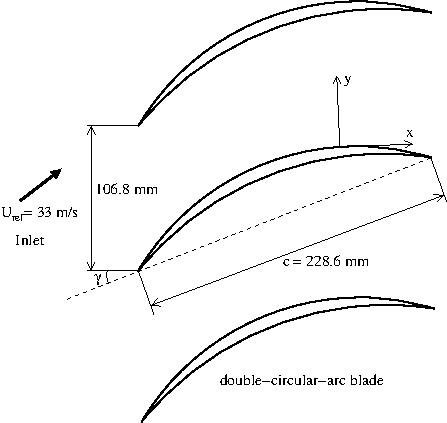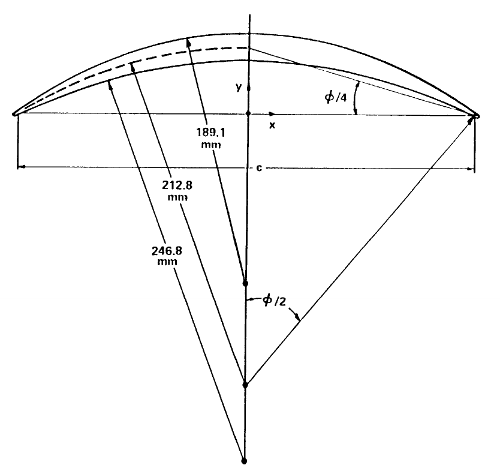Transitional Cascade Blade
Experiments by Zierke and Deutsch
Description
Flow around a highly loaded compressor blade in cascade at three different incidence angles.
2D flow with constant temperature.
Geometry
Domain around a double-circular-arc blade.
The double-circular-arc blade geometry is shown in figure 1. Equations for the pressure surface, suction surface and camberline are given by \[ x_p^2 + (y_p + 219.7)^2 = 246.8^2 \] \[ x_s^2 + (y_s + 149.5)^2 = 189.1^2 \] \[ x_c^2 + (y_c + 179.4)^2 = 212.8^2 \] where the origin is taken at the mid-point of the chord line, and all dimensions are in millimetres. The leading and trailing edges were machined to be circular, with radii of \(0.9144\) mm, meeting the two blade surfaces at the tangency points. The chord length \(c=228.6\) mm is measured from the centre of the leading edge circle to the centre of the trailing edge one.
The blades are arranged in a cascade, as shown in figure 2.
 Fig. 2: Blade cascade geometry
Fig. 2: Blade cascade geometry
Features of the blades separated by a distance of \(s=106.8\) mm:
- centreline curvature radius: \(212.8\) mm
- camber angle: \(\phi=65\)o
- stagger angle: \(\gamma=20.5\)o
- chord length: \(c = 228.6\) mm
- solidity: \(c/s=2.14\)
- radius of both the leading and the trailing edges: \(0.9144\) mm
Flow Characteristics
A periodic, two-dimensional cascade flow has been developed without the use of continuous side wall suction.
Near the leading edge, the incidence angle causes the stagnation point to lie on either the pressure or suction surface of the blade. On this stagnation surface, the streamwise pressure gradient begins as favourable and results in a region where the boundary layer is laminar. Further downstream, an adverse streamwise pressure gradient either causes the laminar boundary layer to separate or initiate natural transition. On the surface opposite of the stagnation point, a severe adverse pressure gradient results in the presence of a separation ``bubble'' which transitions the flow to turbulence.
After the trailing edge, the near wake structure shows no similarity or self-preservation characteristics. Downstream, the far wake velocity profile shows Gaussian similarity.
Flow Parameters
Air with a kinematic viscosity \(\nu = 1.5 \times 10^5\) m2/s and a density \(\rho = 1.205\) kg/m2.
Inlet mean velocity: \(U_{ref} = 33\) m/s.
Reynolds number based on the chord: \(Re_c = U_{ref}c/\nu\).
Three different incidence angles have been imposed to the inlet flow: 5.0o, -1.5o and -8.5o.
Inflow Conditions
Constant mean velocity profile and turbulent quantity levels compatible with a free-stream turbulence intensity level of \(0.18\% \pm 10\%\).
Experimental Details
Velocity measurements using a one-component LDV system.
Static pressure measurements.
Measurement Errors:
The standard deviations are provided for each velocity measurement in the data files.
Available Measurements
For the three different incidence angles, the following measurements are provided:
- Pressure distribution around the blade.
- Profiles at selected positions around the blade and across the wake of:
- First order moment: \(U\)
- Second order moment: \(\overline{u^2}/U_{ref}^2\)
- Skewness and Flatness: \(S_u\), \(F_u\)
The data can be downloaded as compressed archives from the links below, or as individual files.
Sample plots of selected quantities are available.
Pressure Measurements
| Incidence Angle | |||
|---|---|---|---|
| \(5^o\) | \(-1.5^o\) | \(-8.5^o\) | |
| \(C_p\) Distribution | pdistp050.dat | pdistm015.dat | pdistm085.dat |
Velocity Measurements
| \(5^o\) Incidence Angle | |||||
|---|---|---|---|---|---|
| Pressure Surface | Suction Surface | Wake | |||
| Location (%chord) | File | Location (%chord) | File | Location (%chord) | File |
| 2.7 | tabp50p0027.dat | 2.6 | tabp50s0026.dat | 105.4 | tabp50w1054.dat |
| 5.9 | tabp50p0059.dat | 7.6 | tabp50s0076.dat | 109.6 | tabp50w1096.dat |
| 14.4 | tabp50p0144.dat | 12.7 | tabp50s0127.dat | 152.6 | tabp50w1526.dat |
| 25.1 | tabp50p0251.dat | 23.0 | tabp50s0230.dat | ||
| 35.8 | tabp50p0358.dat | 33.2 | tabp50s0332.dat | ||
| 46.5 | tabp50p0465.dat | 43.3 | tabp50s0433.dat | ||
| 57.2 | tabp50p0572.dat | 53.6 | tabp50s0536.dat | ||
| 68.0 | tabp50p0680.dat | 63.2 | tabp50s0632.dat | ||
| 78.6 | tabp50p0786.dat | 74.0 | tabp50s0740.dat | ||
| 89.3 | tabp50p0893.dat | 84.2 | tabp50s0842.dat | ||
| 97.9 | tabp50p0979.dat | 94.9 | tabp50s0949.dat | ||
| \(-1.5^o\) Incidence Angle | |||
|---|---|---|---|
| Pressure Surface | Suction Surface | ||
| Location (%chord) | File | Location (%chord) | File |
| 55.1 | tabm15p0551.dat | 7.3 | tabm15s0073.dat |
| 9.4 | tabm15s0094.dat | ||
| 14.5 | tabm15s0145.dat | ||
| \(-8.5^o\) Incidence Angle | |||||
|---|---|---|---|---|---|
| Pressure Surface | Suction Surface | Wake | |||
| Location (%chord) | File | Location (%chord) | File | Location (%chord) | File |
| 4.3 | tabm85p0043.dat | 10.4 | tabm85s0104.dat | 106.0 | tabm85w1060.dat |
| 9.7 | tabm85p0097.dat | 19.7 | tabm85s0197.dat | 109.7 | tabm85w1097.dat |
| 20.5 | tabm85p0205.dat | 30.1 | tabm85s0301.dat | 131.9 | tabm85w1319.dat |
| 30.3 | tabm85p0303.dat | 40.5 | tabm85s0405.dat | ||
| 40.0 | tabm85p0400.dat | 49.8 | tabm85s0498.dat | ||
| 49.7 | tabm85p0497.dat | 55.0 | tabm85s0550.dat | ||
| 60.5 | tabm85p0605.dat | 60.2 | tabm85s0602.dat | ||
| 70.3 | tabm85p0703.dat | 70.6 | tabm85s0706.dat | ||
| 80.0 | tabm85p0800.dat | 80.0 | tabm85s0800.dat | ||
| 89.7 | tabm85p0897.dat | 90.3 | tabm85s0903.dat | ||
| 98.4 | tabm85p0984.dat | 97.6 | tabm85s0976.dat | ||
Main references
- Zierke, W.C., Deutsch, S. (1989). The measurement of boundary layers on a compressor blade in cascade - Vols. 1 and 2. NASA CR 185118.
Indexed data:
| case015 (dbcase, flow_around_body) | |
|---|---|
| case | 015 |
| title | Transitional Cascade Flow |
| author | Zierke, Deutsch |
| year | 1989 |
| type | EXP |
| flow_tag | 2d, streamlined_body |
